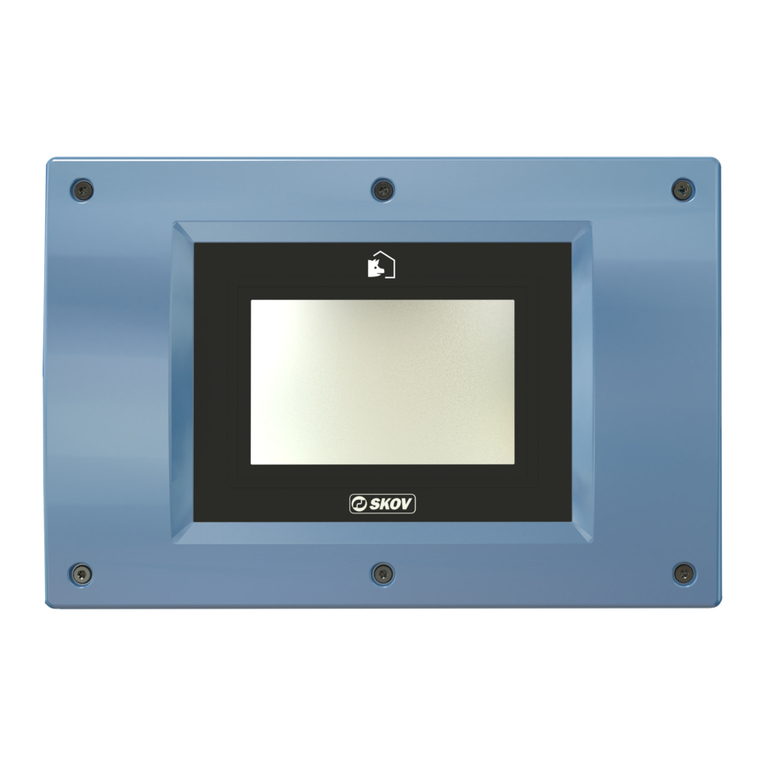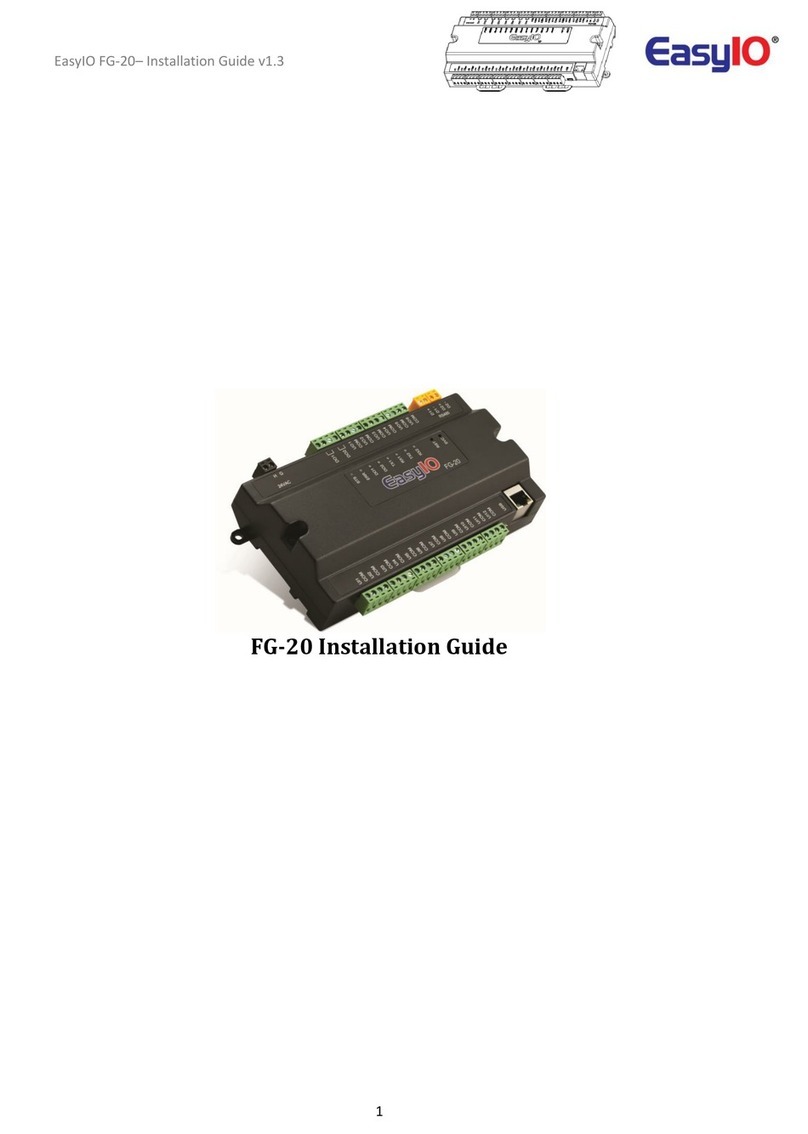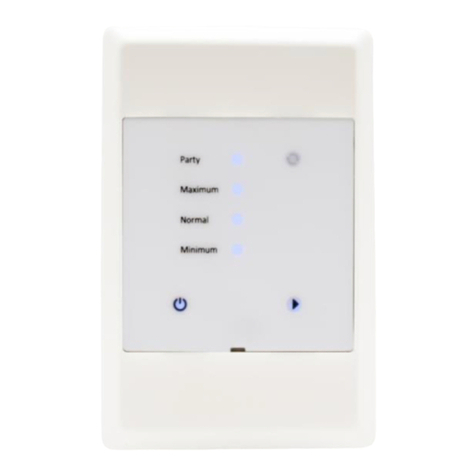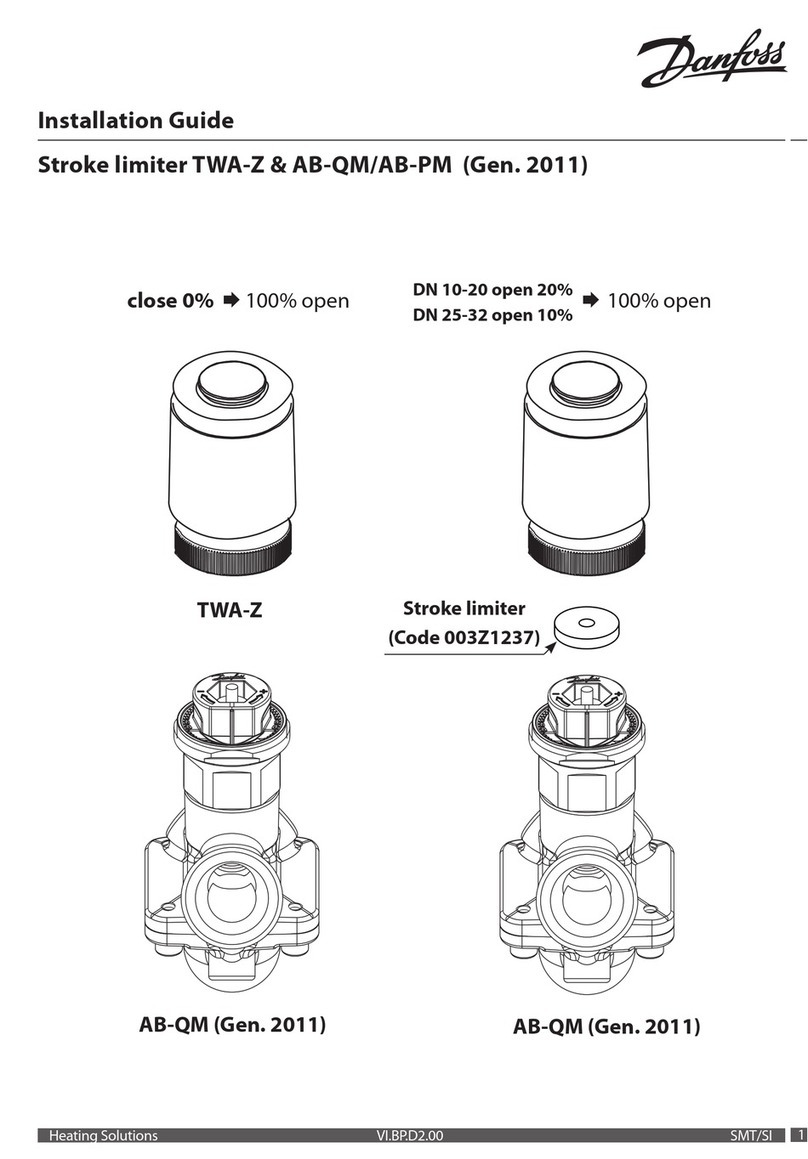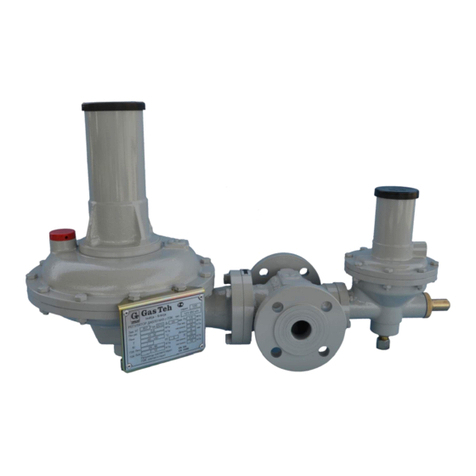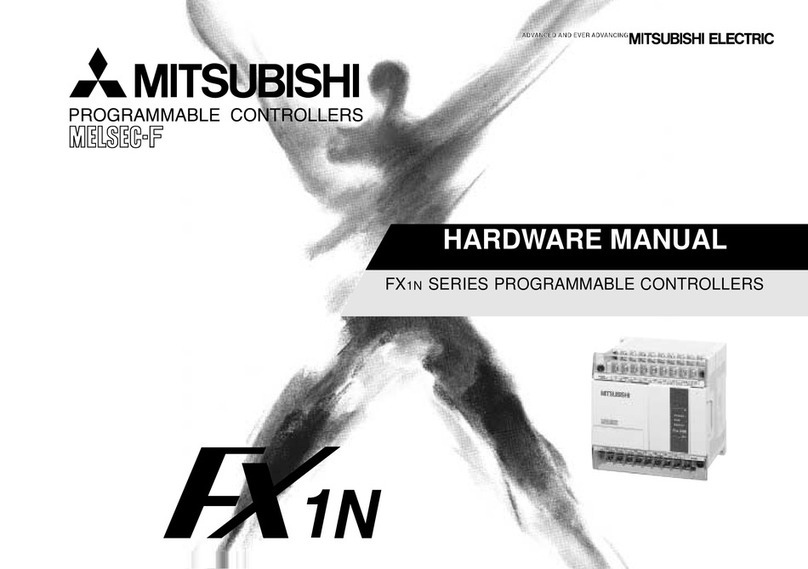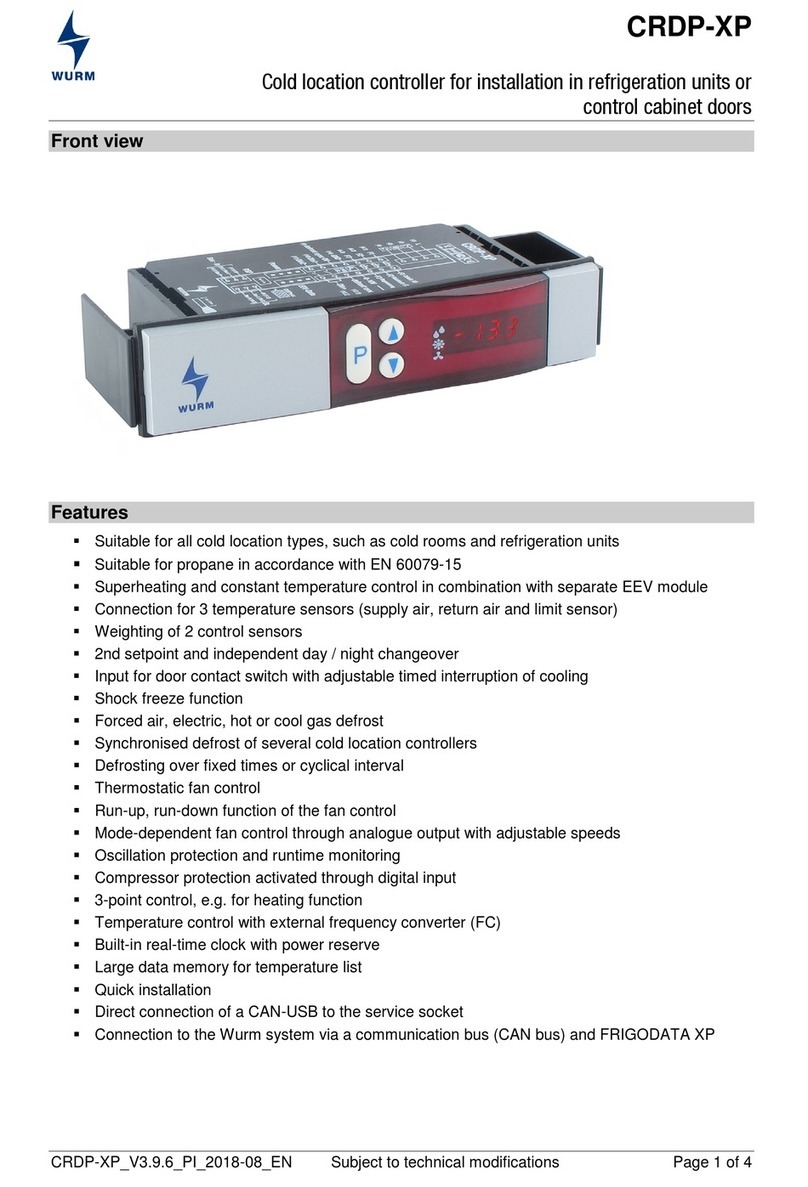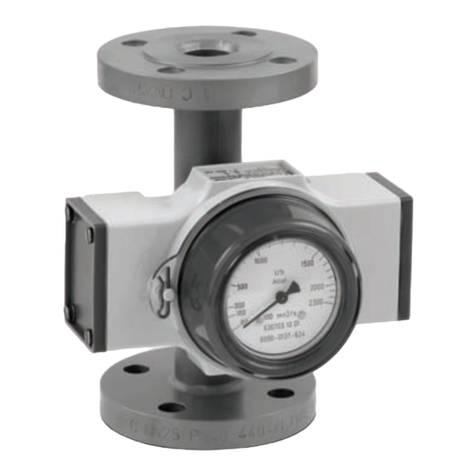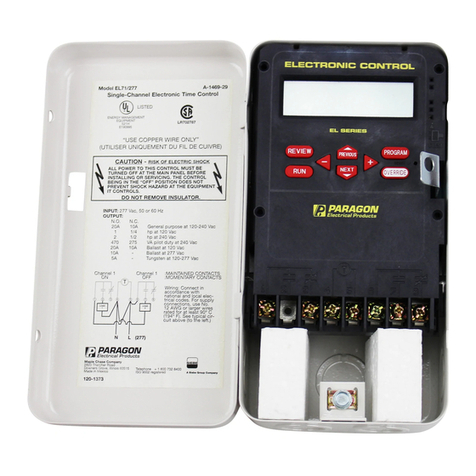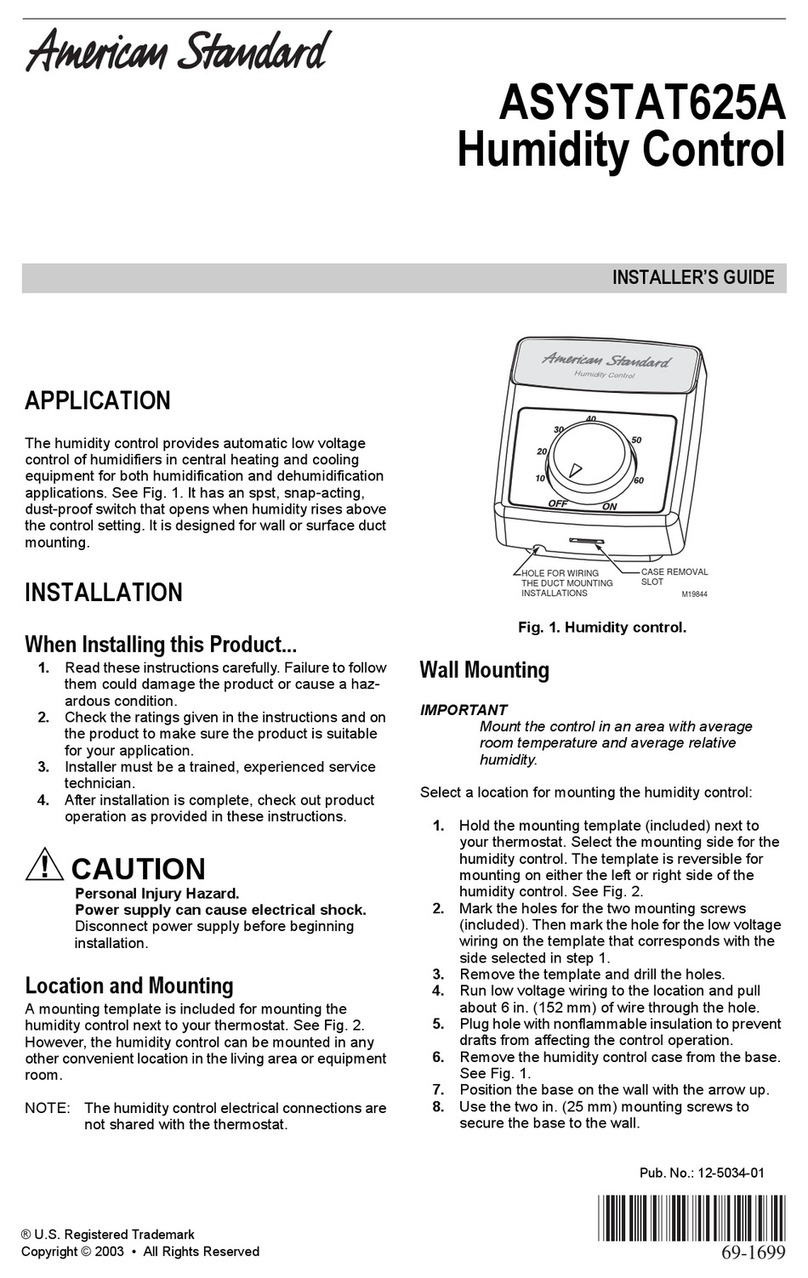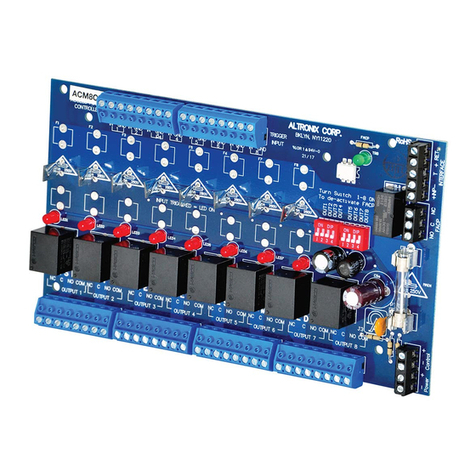Atest Gaz Control V User manual

POD-067-ENG R01
User Manual
Valve Controller
Control V
Product code: PW-121-X

We design, manufacture, implement and support
Systems for Monitoring, Detection and Reduction of gas hazards
We invite you to familiarize yourself with our offer on www.atestgaz.pl
Atest Gaz A. M. Pachole sp. j.
ul. Spokojna 3, 44-109 Gliwice
Poland
tel. +48 32 238 87 94
fax +48 32 234 92 71
e-mail [email protected]
www.atestgaz.pl

www.atestgaz.pl
Remarks and reservations
Read and understand this manual prior to connection and operation of the device. Keep the User
Manual with the device for future reference.
The manufacturer shall not be held responsible for any errors, damage or defects caused by
improper selection of suitable devices or cables, errors in installation of equipment or any misuse
due to failure to understand the document content.
Unauthorised repairs and modifications of the device are not allowed. The manufacturer shall
discard any responsibility for consequences of such actions.
E posure of the device to the impact of e cessive mechanical, electric or environmental factors
may lead to damage of the device.
Operation of damaged or incomplete devices in not allowed.
Engineering of a gas safety system for any specific facilities to be safeguarded may need
consideration of other requirements during the entire lifetime of the product.
Use of unauthorized spare parts different from the ones listed in Table 9 is strictly forbidden.
How to use this manual
The following symbols of optical indicators status are used throughout the document:
Symbol Interpretation
Optical indicator on
Optical indicator flashing
Optical indicator off
Optical indicator status not determined (depends on other factors)
Table 1: Optical indicators status notation
Important fragments of the te t are highlighted in the following way:
Pay e treme attention to information provided in such framed bo es.
This User Manual consists of a main te t and attached appendices. The appendices are
independent documents and can be used separately from this Manual. Page numbering of
appendices starts anew with no relationship to pare numbering of the main document and
appendices may have their own tables of contents. In the right bottom corner of each page you
can find the name (symbol) of any document included into the User Manual package with its
revision (issue) number.
s. 3|15 User Manual POD-067-ENG R01

www.atestgaz.pl
Table of contents
1 General information................................................................................................................................5
1.1 Operation principle...........................................................................................................................5
2 Safety......................................................................................................................................................5
3 Description of the construction...............................................................................................................6
4 Input-output interfaces...........................................................................................................................7
4.1 Electric interface...............................................................................................................................7
5 User interface..........................................................................................................................................8
5.1 Device status.....................................................................................................................................8
5.2 Battery status....................................................................................................................................8
5.3 Valve status.......................................................................................................................................9
5.4 TEST button.......................................................................................................................................9
6 System architecture.................................................................................................................................9
7 Life cycle................................................................................................................................................10
7.1 Transportation.................................................................................................................................10
7.2 Installation......................................................................................................................................10
7.3 Start up...........................................................................................................................................11
7.4 Configuration of the controller /system..........................................................................................12
7.5 Maintenance schedule....................................................................................................................12
7.6 Utilization........................................................................................................................................13
8 Technical specification...........................................................................................................................14
9 List of consumables...............................................................................................................................15
10 Product marking..................................................................................................................................15
11 Appendices..........................................................................................................................................15
List of Tables
Table 1: Optical indicators status notation...................................................................................................3
Table 2: Electric interface description..........................................................................................................7
Table 3: Meaning of LED indicators in the device status..............................................................................8
Table 4: Meaning of LED indicators in the battery status.............................................................................8
Table 5: Meaning of LED indicators in the valve status................................................................................9
Table 6: Description of TEST button.............................................................................................................9
Table 7: Selection of cables for connection between the Control V unit and the valve..............................11
Table 8: Technical specification..................................................................................................................14
Table 9: List of consumables......................................................................................................................15
List of Figures
Figure 1: Location and function of the Control V controller within the Teta Gas Safety System...................5
Figure 2: The construction of the device and its dimensions.......................................................................6
Figure 3: Electric Connections......................................................................................................................7
Figure 4: Front panel...................................................................................................................................8
Figure 5: Example of the Teta system layout with a Control V module included..........................................9
Figure 6: Example of the Control V device connection when the DI port is used for control......................10
Figure 7: Example connection of cables to the device................................................................................11
Figure 8: Example of the controller configuration (address = 55, opening of DI contacts leads to valve
shutoff).....................................................................................................................................................12
s. 4|15 User Manual POD-067-ENG R01

www.atestgaz.pl
1 General information
The Control V device is a local controller for a gas shutoff valve. Its location within close vicinity of the valve
and a built-in rechargeable battery make it possible to avoid many problems related to voltage drops down
long electric cables and conductors.
The valve can be controlled by means of a binary signal (DI) or via the Teta data transmission interface. It is
why the valve controller of Control V type perfectly enables e tension of functionalities offered by any
monitoring systems, in particular the Gas Safety System offered by Atest Gaz.
Figure 1: Location and function of the Control V controller within the Teta Gas Safety System
1.1 Operation principle
Upon receiving a command via the Teta data transmission interface or a digital input (DI) the Control V valve
controller produces a waveform necessary to shut off a valve.
Operation of the controller is subjected to continuous monitoring of its operability and its key parameters,
where such items as continuity of the line for valve control (its resistance), charging status of the embedded
battery and level of power voltage are checked on-line in the automatic mode.
The Control V unit also reports a need to test the valve and enables manual e ecution of such a test – see
details in Section 7.5.1.
2 Safety
All activities related to connecting detectors, signallers and other system components must
be carried out while Control Unit's power supply is off.
Although switching power supply of the Gas Detection and Safety System off, there is
a possibility that a dangerous voltage can e ist on the terminals of the control unit. It can
originate from another system like for an e ample ventilation system that uses one of the
output pins of control unit.
s. 5|15 User Manual POD-067-ENG R01
Teta
EcoN
Teta
MiniDet
Teta
EcoWent
TOLED
Teta
EcoWent
Teta
EcoWent
T-connector S2 T-connector S2 T-connector S2
Teta
MOD Control 1
Ventilation
Fire safety
BMS
Control V
T-connector S2

www.atestgaz.pl
When performing repair, building and maintenance works, secure the device in a proper
way.
Before painting the floors, make sure the device is secured.
3 Description of the construction
Product code
Dimensions [mm]
A B C D E
PW-121-L-X 125 110 125 110 75
PW-121-H-X 175 160 125 110 100
Figure 2: The construction of the device and its dimensions
s. 6|15 User Manual POD-067-ENG R01

www.atestgaz.pl
4 Input-output interfaces
4.1 Electric interface
Figure 3: Electric Connections
Name Terminal Description
Valve power supply port. Parameters – see section 4.1.1
- Negative
+ Positive
INV. FAULT Relay output of the fault signal (inverted) – see details in Section 4.1.2
COM Common terminal of relay
NC Normally closed contact of relay
NO Normally open contact of relay
DI Binary input – details, see section 4.1.3
DI1 Input DI1
DI2 Input DI2
TETA BUS System communication port designed to connect devices of the Teta series, see
details in Section 4.1.4
When the unit is controlled e clusively via the DI line this port is used only for power
supply of the unit.
- Power supply and control line for Teta bus / negative
+ Power supply and control line for Teta bus / positive
Table 2: Electric interface description
4.1.1 Power supply port for a valve to be controlled
The output port designed to supply a shutoff valve. The port is monitored (resistance of the output line is
continuously measured) and its parameters are similar to the ones specified in Table 8.
4.1.2 Relay output of the fault signal
The output is active (COM and NO terminals are shorted) during faultless operation of the valve controller
(neither the controller nor the power supply line for the valve are defective).
The output is inactive (COM and NO terminals are open) when any faults are detected either in the valve
controller or the power supply line for the valve or power supply voltage is missing).
4.1.3 DI port
The port is designed for direct control of a shutoff valve by means of a signal that can be provided by
another system for automatic control, an alarm system or a pushbutton. Parameters – see Table 8.
s. 7|15 User Manual POD-067-ENG R01
- + COM NC NO DI1 DI2 - +
INV. FAULT DI TETA BUS

www.atestgaz.pl
The port is configurable and the shutoff valve can be closed either by opening or closing the DI contacts
– see details in Section 7.4.2.
4.1.4 Teta Bus port
The digital communication and power supply port compatible to the Teta BUS communication protocol.
designed to connect the valve controller to the entire system of the Teta Gas Safety System. Enables both
power supply and digital communication with other devices of the Teta series (PLN – Power Line
Networking).
5 User interface
Figure 4: Front panel
5.1 Device status
Indicator Status / colour Information
/ green Regular operation of device
No internal failures are reported
/ yellow Internal failure of the device
Table 3: Meaning of LED indicators in the device status
5.2 Battery status
Indicator Status / colour Information
Regular operation of battery
/ yellow Failure of the battery
Table 4: Meaning of LED indicators in the battery status
s. 8|15 User Manual POD-067-ENG R01
Device status
Valve status
Battery status
Button

www.atestgaz.pl
5.3 Valve status
Indicator Status / colour Information
Regular operation of valve
/ yellow Valve failure (e.g. valve is missing, control line for the valve is shorted).
Table 5: Meaning of LED indicators in the valve status
5.4 TEST button
The TEST button is used to manually start the valve test – see Section 7.5.1.
Indicator Status / colour Information
No need to test the valve
/ green Slow blinking of the LED indicator – test of the valve is needed (see details in
Section 7.5.1)
/ green Test of the valve is in progress
Table 6: Description of TEST button
6 System architecture
Figure 5: Example of the Teta system layout with a Control V module included
s. 9|15 User Manual POD-067-ENG R01
Field detector 1 Field detector 2 Field detector 3 Field detector n
T-connector
S2
T-connector
S2
T-connector
S2
T-connector
S2

www.atestgaz.pl
Figure 6: Example of the Control V device connection when the DI port is used for control
7 Life cycle
7.1 Transportation
The device should be transported in the same way as new devices of this type. If the original bo or another
protection (e.g. corks) is not available, it is necessary to secure the device against shocks, vibrations and
moisture on one's own, using other equivalent methods.
The device can be conveyed under environmental conditions as described in Table 8.
7.2 Installation
The device should be mounted on a flat a vertical wall with cable glands downwards, where the mounting
position is shown in 2. The location of the device should be easily accessible to operating personnel but
access of unauthorized persons should be restricted as much as possible. It is recommended to install the
device at the height that enable easy access to the device.
Combining two or more wires at a single terminal is not allowed if such wires are not
clamped in a common cable ferrule (details see Table 8).
Leaving spare lengths of cables inside the device is not allowed. Bare wires or wires surplus
may lead to a hazard of electric shock or equipment damage.
All cable cores must be terminated inside the device. Leaving unterminated cores is not
allowed.
s. 10|15 User Manual POD-067-ENG R01
Power
Supply

www.atestgaz.pl
Not used screw terminals must be tightly screwed.
Incorrect routing of cables may result in impairment of the equipment immunity to
electromagnetic interferences.
Figure 7: Example connection of cables to the device
7.2.1 Valve connection Ω
Designers of the wiring for connection of the valve controller to the shutoff valve must pay particular
attention to appropriate selection of cables so that the ma imum permissible resistance allowed for
connection line is not e ceeded: 0.2 for valves with power consumption less or equal 72 W or 0.5 for
valves with power consumption less or equal 36 W.
Please keep in mind that the total length of conductors is twice more than the cable length. The table below
e plains how to select cross-section of cable cores and length of cables for valves of various types.
Cross-section of cable
cores [mm2]
Cross-section of a cable
(parallel connection of
cores) [mm2]
Maximum length of the cable
for valves with power ≤ 72 W
[m]
Maximum length of the cable
for valves with power ≤36 W
[m]
1.5 2 1.0 not recommended 20
2.5 2 1.5 10 30
4 2 2.5 20 50
6 2 4 30 -
Table 7: Selection of cables for connection between the Control V unit and the valve
7.3 Start up
After making sure that all connections are correct it is possible to power up the device.
Upon power up all indicators of the user interface panel should be on for about 1 second. Then the device
switches to the mode of regular operation, which is indicated as e plained in Section 5.
To check whether installation of the entire system is correct it is recommended to run a comprehensive test
of the system by manual tripping of a gas alarm for the time not less than 30 seconds on any of gas
detectors incorporated into the system (the procedure of alarm tripping is described in manuals for each
s. 11|15 User Manual POD-067-ENG R01
Incorrect cable routing Correct cable routing

www.atestgaz.pl
specific gas detectors). After activation of the alarm procedure the control unit should indicate e ceeding of
the alarm level in a specific monitoring channel, the warning visual and sound warning devices must be
activated and the valve controller must close the gas valve.
7.4 Configuration of the controller /system
The controller configuration is carried out by setting of appropriate switches in the SW1 dip-switch unit
– see Figure 8.
Figure 8: Example of the controller configuration (address = 55, opening of DI contacts leads to valve
shutoff)
7.4.1 Address setting
The controller address ca ne set by means of switches 1...3. It is possible to set the address from 51 to 58.
7.4.2 Configuration of the DI port
Operation mode for the DI port can be selected by means of the switch 4.
Setting the switch to the ON position means that open contacts of the DI port lead to closing of a shutoff
valve connected to the controller. On the contrary, moving the switch to the OFF position makes the
controller to close the shutoff valve connected to the valve port when the contacts of the DI port are
shorted (see Figure 6).
7.5 Maintenance schedule
It is recommended to carry out scheduled maintenance of the controller after each three months of its
operation.
The scheduled maintenance includes:
visual inspection of the system and its individual components from the outside,
test of the valve operability.
7.5.1 Valve test
The controller enables manual test of the valve operation.
The reminder to initiate the valve test is activated after each three months from the last check of the valve
by regular blinking of the TEST indicator.
The test is carried out manually by the system operator from the level of the valve controller. Prior to run
the tests make sure that temporary shut off of gas supply is allowed at the moment according to operation
procedures affective for the specific gas supply system. To run the test proceed according to the following
sequence:
s. 12|15 User Manual POD-067-ENG R01
SW1
ADDR. = 51
+1 +2 + 4 DI INV.

www.atestgaz.pl
depress the TEST button for about five seconds (the TEST indicator should go on afterwards),
make sure that the controlled valve is closed,
reopen the valve.
In any irregularities are found out in the procedure of the valve closing please contact the manufacturer or
a service company.
When the controller reports the valve failure (see Table 5) or low voltage of the controller
battery (see Table 4) e ecution of the test is disabled.
7.5.2 Replacement of consumables and fast wearing parts
Lifetime of consumables and fast wearing parts is listed in Table 9.
7.5.2.1 Replacement of battery
To replace the controller battery follow the procedure below:
disconnect the controller from power voltage,
remove the lid,
disconnect the battery,
replace the battery with a new one,
repeat the disassembling procedure in the reverse order.
7.5.3 Maintenance
E cept cleaning the e ternal part of the enclosure, the device does not require any maintenance. The
e ternal part of the enclosure should be cleaned by means of a soft cloth moistened with water and a bit of
a mild detergent.
7.6 Utilization
This symbol on a product or on its packaging indicates that the product
must not be disposed of with other household waste. Instead, it is the
user's responsibility to ensure disposal of waste equipment by handing it
over to a designated collection point for the recycling of waste electrical
and electronic equipment. The proper recycling of your waste equipment
at the time of disposal will help to conserve natural resources and ensure
that it is recycled in a manner that protects human health and the
environment. Information about relevant designated collection points can
be obtained from the Local Authority, waste disposal companies and in the
place of purchase. The equipment can also be returned to the
manufacturer.
s. 13|15 User Manual POD-067-ENG R01

www.atestgaz.pl
8 Technical specification
Power supply
• VCC
• Power consumption
15 – 50 V
3 W
Environment
• Ambient temperatures
• Humidity
• Pressure
-20 – 40OC
10 – 90% long term
0 – 99% short term
1013 ± 10% hPa
IP IP 65
Two-state outputs parameters
• Relay Floating contacts, NO/NC: 24 V / 0.1 A,
Not protected against overloading
Control output for the shutoff valve
• Range of load resistance /power
• Guaranteed limit of the shutoff voltage
• Ma imum resistance of the power supply line
• Duration of the shutoff pulse
PW-121-L-X: ≥ 4 Ω / ≤ 36 W
PW-121-H-X: ≥ 2 Ω / ≤ 72 W
10.5 V
See Section 7.2.1
0.5 s
Parameters of the input for an e ternal alarm signal Connection via a potential-free contact
Inactive for resistance below 10 Ω
Active for resistance above 3300 Ω
Minimum duration of the switchover pulse > 1s
Digital communication parameters
• Teta BUS port
• Communication protocol Teta BUS
Integrated signalling equipment (visual) LED controls
Protection class III
Dimension See Figure 2
Cable glands
• Cable diameter range 5 – 10 mm
Cross-section of wires for clamping terminals
• Relay outputs, DI, TETA
• Power voltage
0.08 – 2.5 mm2 (use sleeves 2 1 mm2 or 2 0,75 mm2 for twin
conductors)
1 – 4 mm2 (use sleeves 2 1.5 mm2 or 2 1 mm2 for twin
conductors)
Enclosure material ABS
Weight PW-121-L-X: 1.0 kg
PW-121-H-X: 2.5 kg
Lifetime of consumables See Table 9, Section 9
Mounting 4 screw holes 4 mm, hole spacing:
PW-121-L-X: 160 110 mm
PW-121-H-X: 110 110 mm
Table 8: Technical specification
s. 14|15 User Manual POD-067-ENG R01

DI
www.atestgaz.pl
9 List of consumables
No. Consumables Lifetime Manufacturer Product code
{1} Fuse 6.3 A - ESKA ESKA 887.125
{2} Battery 12 V, 1.3 Ah 1 year MW Power MW-1,3-12
{3} Battery 12 V, 5 Ah 1 year MW Power MW-5-12
Table 9: List of consumables
10 Product marking
Control V Valve Controller PW-121- -
Valve type L Coil resistance ≥ 4 Ω, power consumption ≤ 36 W
H Coil resistance ≥ 2 Ω, power consumption ≤ 72 W
Digital interface T Teta Bus
T.485 Teta Bus + RS-485
11 Appendices
[1] DEZG-141-ENG – EC Declaration of Conformity – Control V
s. 15|15 User Manual POD-067-ENG R01
V
V DI

www.atestgaz.pl
EU Declaration of Conformity
Atest Gaz A. M. Pachole sp. j. declares with full responsibility, that the product:
(Product description)
Valve Controller
(Trade na e)
Control V
(Type identifier or Product code)
PW-121
co plies with the following Directives and Standards:
in relation to Directive 2014/30/EU – on the har onisation of the laws of the Me ber States
relating to electro agnetic co patibility:
• EN 50270:2015
in relation to Directive 2014/35/EU – on the har onisation of the laws of the Me ber States
relating to the aking available on the arket of electrical equip ent designed for use within
certain voltage li its:
• EN 60335-1:2012
in relation to directive 2011/65/EU – on the restriction of the use of certain hazardous substances
in electrical and electronic equip ent
• EN 50581:2012
other:
• EN 60529:1991
This declaration of confor ity is issued under the sole responsibility of the anufacturer.
Purpose and scope of use: product is intended for use in gas detection syste s for residential, co ercial
and industrial environ ent.
This EU Declaration of Confor ity beco es not valid in case of product change or rebuild without
anufacturer's per ission.
Gliwice, 29.04.2020
Atest Gaz A. M. Pachole sp. j.
ul. Spokojna 3, 44-109 Gliwice, Poland
VA No.: PL 9691433231
tel.: +48 32 238 87 94
fax: +48 32 234 92 71
e-mail: [email protected]
p. 1/1 DEZG141-ENG R01
Managing Director
Aleksander Pachole
….........................................................
(Na e and Signature)




This manual suits for next models
1
Table of contents
Popular Controllers manuals by other brands
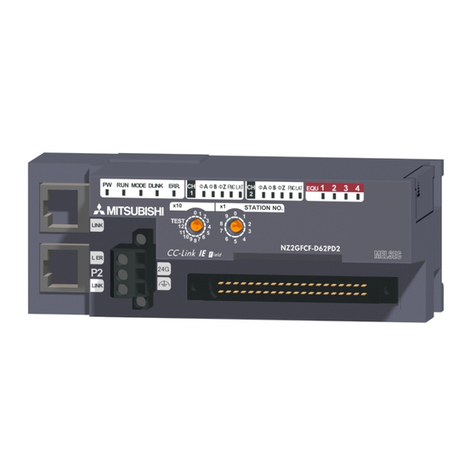
Mitsubishi
Mitsubishi NZ2GFCF-D62PD2 user manual
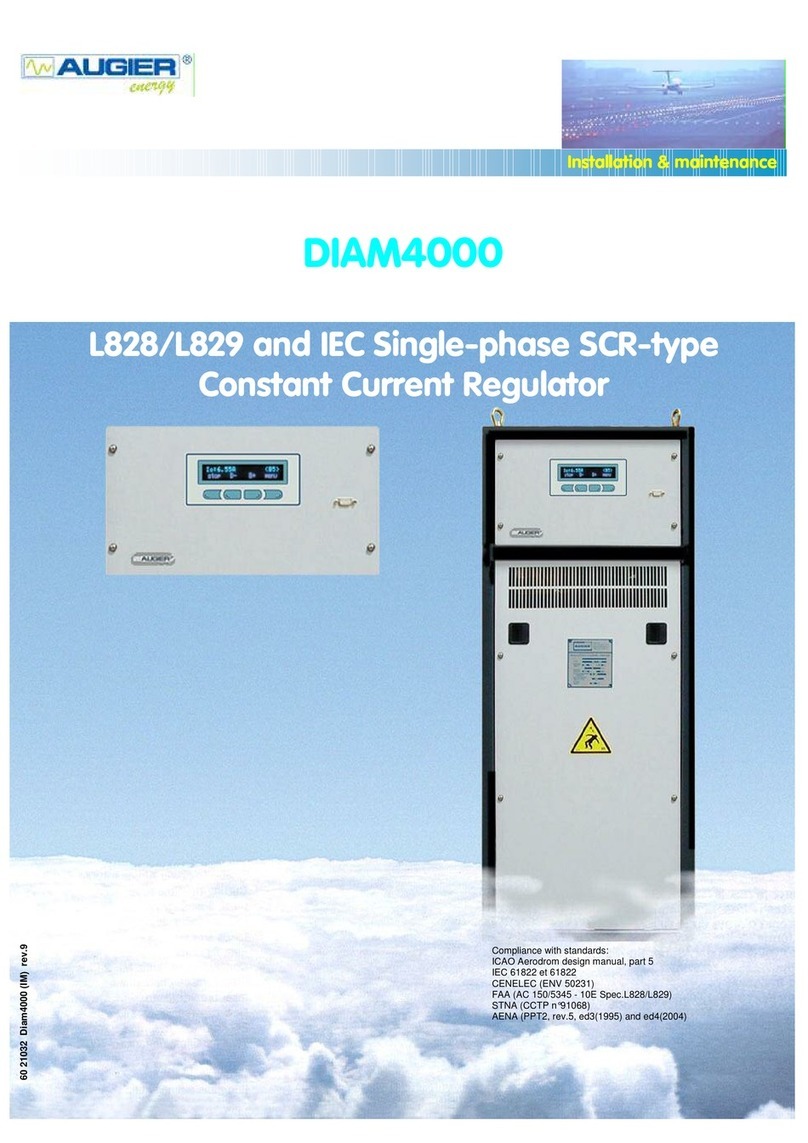
AUGIER Energy
AUGIER Energy DIAM4000 Installation & maintenance
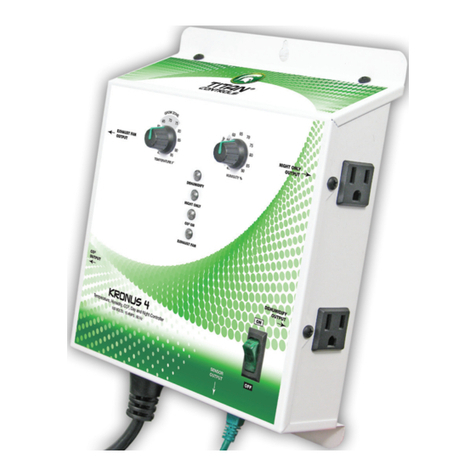
Titan Controls
Titan Controls Kronus 4 instruction manual
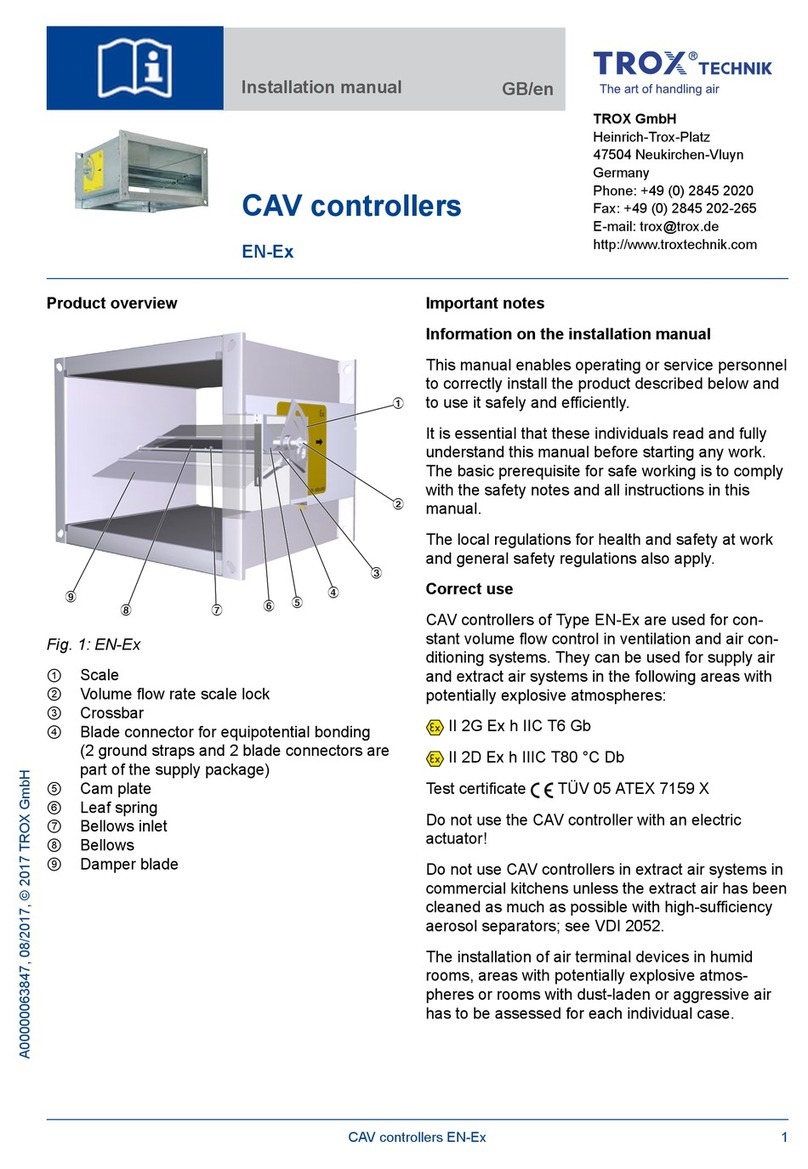
Trox
Trox EN-Ex installation manual
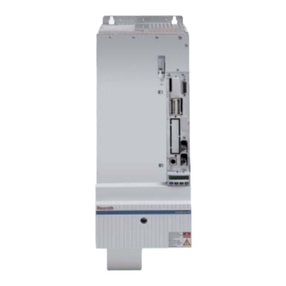
Bosch
Bosch Rexroth IndraDrive MPH-02 Functional description
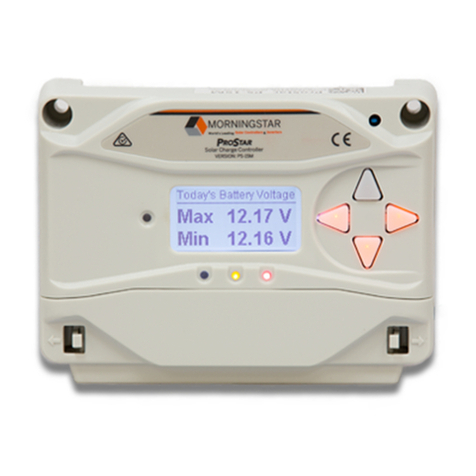
Morningstar
Morningstar ProStar PS-15 Installation, operation and maintenance manual
